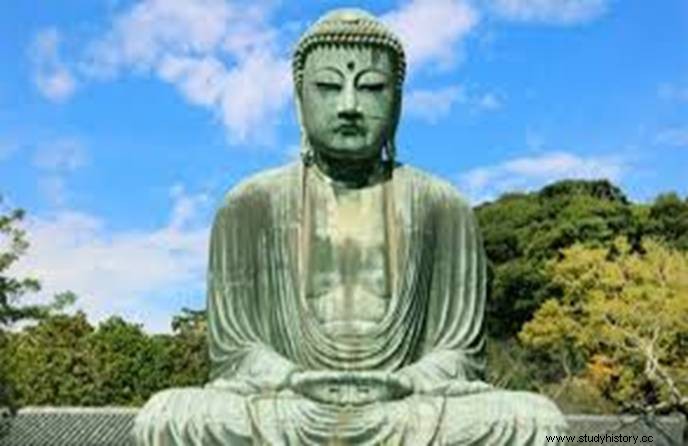
Comparative Study of Jainism and Buddhism
Both Jainism and Buddhism spread at the same time, in the same way, under similar circumstances and with similar objectives. For this reason, historians considered Mahavira and Buddha to be the same person for a long time and considered these two religions to be two forms of the same religion, but by comparing these two religions, the similarities and dissimilarities of both become clear.
Similarities between Jainism and Buddhism
(1.) Both Buddhism and Jainism emerged as a reaction against 'Brahmin religion'. Therefore, both the religions do not accept the authenticity of the Vedas, the main text of Brahmin religion, nor do they consider them as the last step of knowledge. For this reason both are counted in atheistic religions.
(2.) Both Buddhism and Jainism oppose the sacrificial, polytheistic and birth-based casteism of Brahmin religion and do not accept the supremacy of Brahmins in social and religious systems.
(3.) Both Buddhism and Jainism do not consider God as the creator of this universe.
(4.) Both the religions oppose the path of Brahminism and believe in the path of retirement. That is, both insist on retirement from worldly pleasures, but both religions accept the need of household religion.
(5.) Virtue and non-violence have a prominent place in both religions.
(6.) Both Buddhism and Jainism believe in the doctrine of karma and rebirth. Brahmin religion considers 'Yajna' and 'Karmakand' as Karma whereas both Buddhism and Jainism do not consider them as 'Karma'.
(7.) The goal of both Buddhism and Jainism is to attain 'Nirvana'. Both the religions believe that every human being has the right to attain Nirvana without any discrimination.
(8.) Both Buddhism and Jainism consider life to be sad. They lack the optimism of Brahmanism.
(9.) There is a Sangh system in both Buddhism and Jainism. There are two categories of followers in both religions - 1. monk-monk, 2. worshiper-worshipper.
(10.) Both Buddhism and Jainism have their own three gems.
(11.) Bhakti had no place in both Buddhism and Jainism in the beginning, but later Bhaktiism emerged in both.
(12.) Both Buddhism and Jainism were initially opposed to person-worship and idol-worship, but later both religions adopted them.
(13.) Both Buddhism and Jainism laid great emphasis on human service.
(14.) Both the religions gave sermons and composed texts in local languages instead of Sanskrit. Jainism adopted Prakrit language and Buddhism adopted Pali language, but later both religions started writing texts in Sanskrit.
(15.) There are many similarities in the lives of the founders of both Buddhism and Jainism. Both Mahavira and Buddha were Kshatriya princes. Both of them got married and entered household life and both had children. At the age of about 30, both of them took sannyas after renouncing family life and did severe penance for the attainment of truth-knowledge. After attaining knowledge, both did the work of propagating religion for public welfare till death.
Disparities between Jainism and Buddhism
There were also many differences between Buddhism and Jainism, which are as follows-
(1.) The original form of Jainism is much older than Buddhism.
(2.) The ultimate goal of both the religions is to attain 'Nirvana' but in Jainism 'Nirvana' means to become painless i.e. to merge the soul into Sadanand, but in Buddhism 'Nirvana' means complete cessation of personality. Is. That is, when a person becomes free from all kinds of lust or attachment, he attains Buddhahood. According to Jainism, 'Nirvana' is possible only after death, whereas according to Buddhism, man can attain 'Nirvana' in this life.
(3.) There is a difference in the means of attaining Nirvana in both the religions. According to Jainism, 'Nirvana' can be attained by penance, worship and body tribulation etc., but Buddhism emphasizes on the middle path because both physical suffering and luxurious life are undesirable.
(4.) Jainism emphasizes on following the Triratna but Buddhism emphasizes on the Eightfold Path.
(5.) Both Buddhism and Jainism are non-violent but in practice Jainism lays more emphasis on non-violence than Buddhism.
(6.) Jainism believes in the existence of the soul but Buddhism is atheist.
(7.) Theoretically both the religions are opposed to the birth-based caste system and advocate social equality, but in practice the followers of Jainism did not adopt the lower castes while the Buddhist Sangha adopted every varna of the society without any discrimination. And given admission to caste.
(8.) Jainism was more tolerant towards other religions. Whereas Buddhism continued to suffer from religious fanaticism. Because of this he had enmity with other religions.
(9.) Jainism has clearly mentioned its views regarding the origin of the universe, but Buddhism is silent on this subject.
(10.) There is a sangha system in both the religions but in Buddhism there is more emphasis on sangha-life whereas the sangha system of Jainism is not so organized.
(11.) The speed with which the spread of Buddhism started, it also declined and disappeared from the land of India, but Jainism spread slowly and its existence also remained in India.
(12.) Jains call the Siddha men of their religion as Tirthankaras while Buddhists call their perfect men as Bodhisattvas.
(13.) Buddhism got the patronage and encouragement of Chakravarti emperors like Ashoka, Kanishka and Harshavardhana, but Jainism got the patronage of local and minor kings. Due to this the spread of Jainism remained very limited in its own country, while Buddhism spread outside India as well.
It is clear from the above facts that despite having substantial similarities between the two religions, there are a lot of dissimilarities and both the religions are clearly different. There was also a feeling of jealousy and animosity towards each other in both the religions. Buddhism was intolerant towards other religions from the beginning, so it attacked Jainism by getting state patronage. This was the reason that the Hun invader Mihirkul who had killed a large number of Buddhists, Jain Acharya Udyotan Suri praised the same Mihirkul as the lord of the whole earth.
